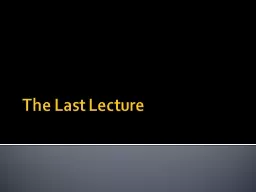

Final Exam December 12 330530 2 hour exam All material from policy agenda formulation forward Responsible for themes for whole course Responsible for specifics of readings and lectures only from agenda and formulation forward except section of Chap 1 ISOS on policy cycle ID: 313642
Download Presentation The PPT/PDF document "The Last Lecture" is the property of its rightful owner. Permission is granted to download and print the materials on this web site for personal, non-commercial use only, and to display it on your personal computer provided you do not modify the materials and that you retain all copyright notices contained in the materials. By downloading content from our website, you accept the terms of this agreement.
Slide1
The Last LectureSlide2
Final Exam
December 12 – 3:30-5:30
2 hour exam
All material from policy agenda+ formulation forwardResponsible for themes for whole courseResponsible for specifics of readings and lectures only from agenda and formulation forward except section of Chap 1 ISOS on policy cycle
2
Review session:
Tu
Dec
10 (Room TBA)
11-12 (whole class)
12-1 (students from whom English in not first language
Office Hours George
Monday Dec 9, 1-4
Wednesday Dec 11, 10-12 and 2-4
By appointment
Office Hours Gabrielle
Friday
Dec 6th,
1-4pm
Monday
Dec 9th,
9-11 am
Tuesday
Dec 10th, 10am-12pmSlide3
outline
Feedback on course
Forest policy futures
Short termBC Liberal FutureWhat if the NDP had won?Longer TermBarriers to more sustainable policyFinal wordsSlide4
Merits of redesign?
Themes
Policy Content
Objective: Draw out broader themes while reducing complexity
Concern: Still too complex?Slide5
Key elements
Forces at work framework
How government works
Interest GroupsFirst NationsInternational ContextUS InfluencePolicy CyclePolicy Formulation
Decision-making and Policy DesignImplementation
New Values: Carbon and Bio-energyComparisons
Cases
Great Bear Rainforest
Mountain Pine Beetle
5
Policy Categories
tenure
Stumpage
Rate of
harvest
Land Use
zoning
Regulation
of Forest Practices
E
mergent areas – carbon, energySlide6
Course design issues
Should there be tutorials
How would you create space for them?Slide7
Course design issues
Website
Facebook page
Twitter feedSlide8
Future Directions
Short term
BC Liberal Future
What if the NDP had won?Longer termSlide9
Christy Clark Forest Policy
Mandate letter
for appointment of Minister Steve Thomson Slide10
MFLNRO mandate letter (1)Slide11
MFLNRO mandate letter (2)Slide12
Christy Clark Forest Policy
Major Campbell initiatives that seem to be continued
Greenhouse gas
reductions?Pacific Carbon Trust eliminated, function retainedPressure on forests will increase to offset LNG emissionsAboriginal reconciliation – signs of move away from treaty focus but that was underwayReorganization – process seems incompleteBut bigger steps impoliticName change?Slide13
Let’s suggest a new name!
Current: Ministry of Forests, Lands, and Natural Resource OperationsSlide14Slide15
An almost NDP FutureSlide16
NDP Platform
New funds
Expanded reforestation
Updated inventory, more R&D on adaptationRestriction on log exportsReduce wood waste, create bio-energy opportunities
http://www.bcndp.ca/files/BCNDP-Platform-2013-Web.pdfSlide17
Longer Term?
What values will we be managing for?
Resurgent commodities
CarbonBioenergyBiodiversityRecreationAestheticsGovernanceCorporatizationPrivatizationDecentralization
(Haley and Nelson’s 3 alternatives)Slide18Slide19
BC Tenure apportioned by AAC
Great sources for BC tenure data
http://www.for.gov.bc.ca/hth/timber-tenures/apportionment/index.htmSlide20
Policies for SFM (Luckert et al)
SFM: optimizing 3 dimensions – now and in the future
Economic
EnvironmentalSocialDiagnosis: failure (too strong?)Slide21
Policy obstacles (Luckert et al)
Undue focus on sustained yield of timber
Insufficiently comprehensive rights
Growing treesMultiple timber speciesEnergyNon-marketForced vertical integration (abandoned in BC)Inefficient land use zoningOverly stringent regulationSlide22
Principles for Change
Integrative management of jointly produced resources
Flexibility
InnovationClaritySlide23
Barriers: Why aren’t we doing better?
Intellectual
Value differences
UncertaintiesPolitical opposition from those benefitting from the status quoDecision rule that advantage opponents to changeInstitutional mismatchPath dependenceSlide24
Path dependence
“once a policy or institutional path is established, entrenched mindsets, interests, and institutions make departures from the status quo difficult to envision” (Luckert et al)Slide25
Final theme
Potential beneficial policy changes are frequently thwarted by intellectual, political, and/or institutional obstacles. Path dependence increases the costs of change.Slide26
Closing thoughts
The meaning is in the detailSlide27
Last word: Critical Thinking
Complexity
Facts and values
Steps:Identify argumentValues underlyingFactsBe respective of value differencesBe conscious of “motivated reasoning”
Mobilize evidencePersuasion requires appealing to their values
Steps in Policy Analysis
Define problem
Criteria for evaluation
Identify multiple alternatives
Outcomes/consequences of alternatives
Compare/tradeoff
Recommended decisionSlide28